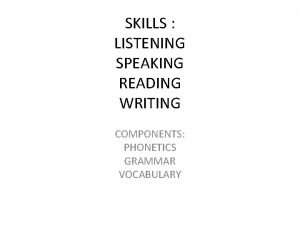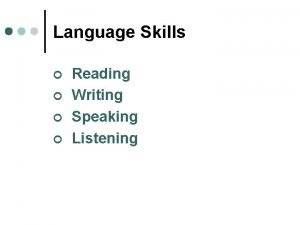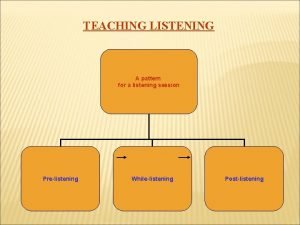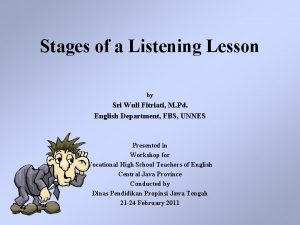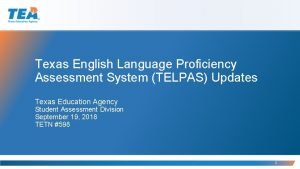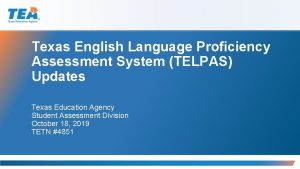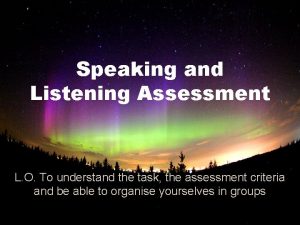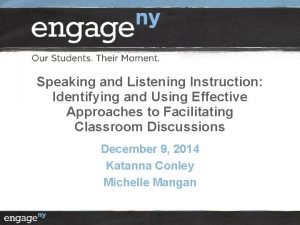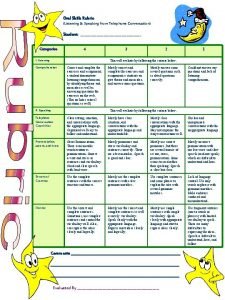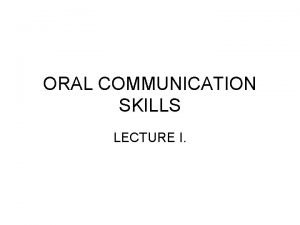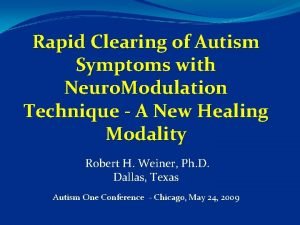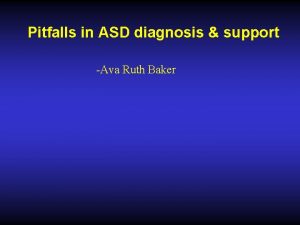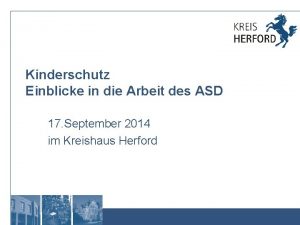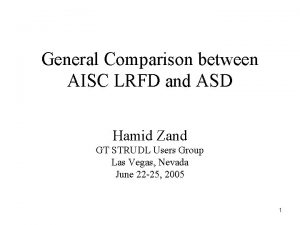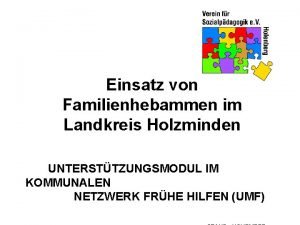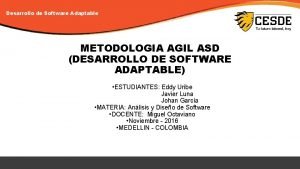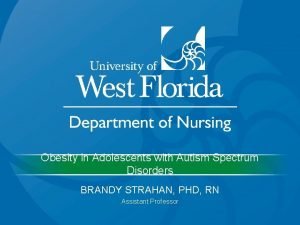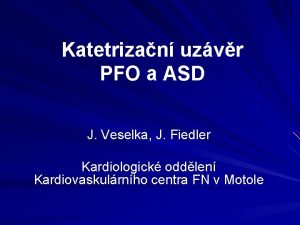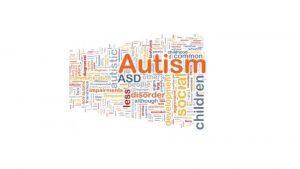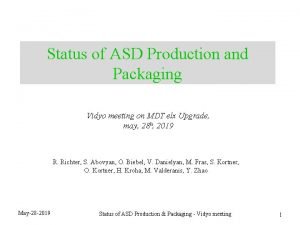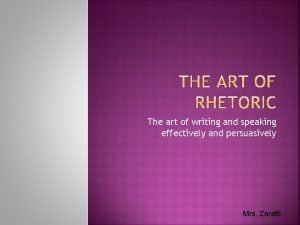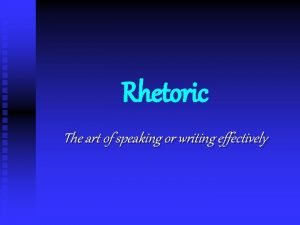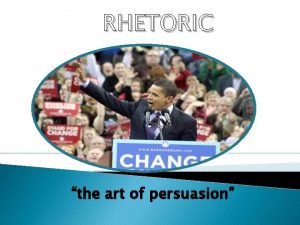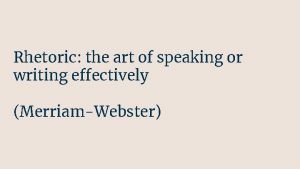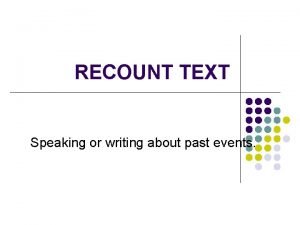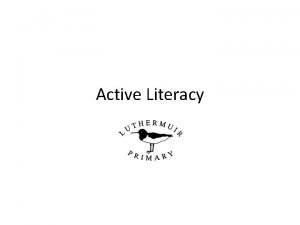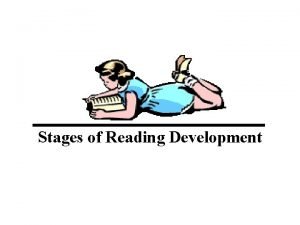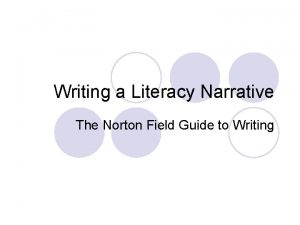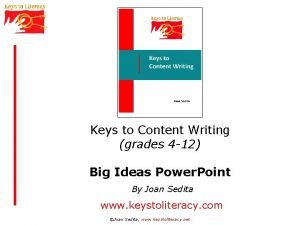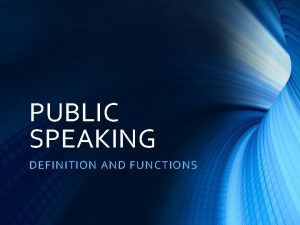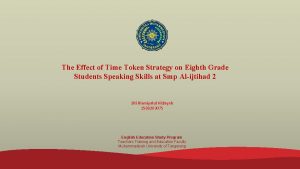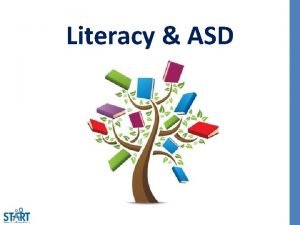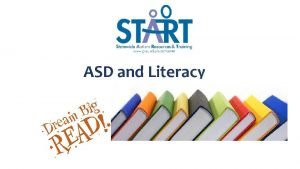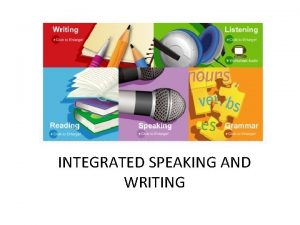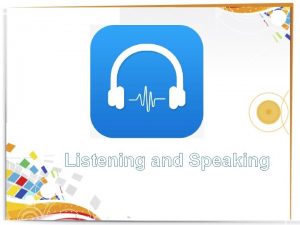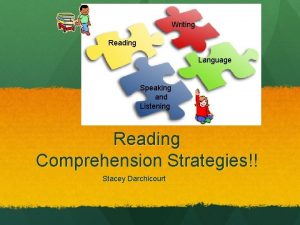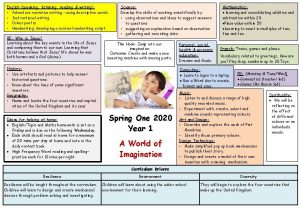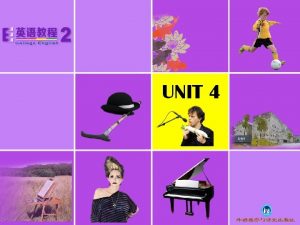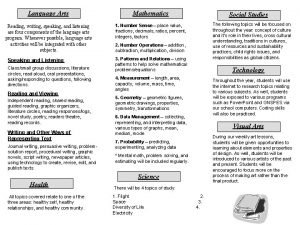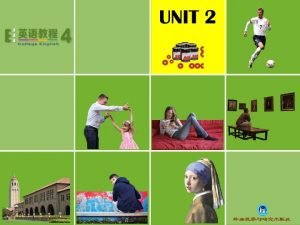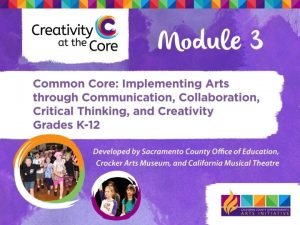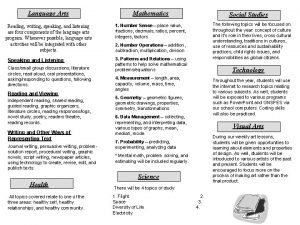Literacy ASD Literacy Definition Reading Writing Speaking Listening





































































- Slides: 69

Literacy & ASD

Literacy - Definition Reading Writing Speaking Listening Pragmatics Critical Thinking Engagement in Literacy Experience Carnahan & Williamson (Eds), 2010

Engagement in Literacy Experiences

Reading – National & State Attention National Assessment of Education Progress (NAEP) National Data: • 31% of Michigan students are proficient in reading at the beginning of 4 th grade (40 th in the country). (Third-Grade Reading Workgroup Report) AUTISM?

Reading and ASD • Limited solid data; • Evidence that decoding & word recognition develop with same processes as typically developing students and often at a faster rate but that comprehension skills do not develop alongside word recognition skills; • More than 65% of students with ASD with measurable reading skills demonstrate comprehension difficulties. Randi, Newman & Grigorenko, 2010

HOW TO TEACH STUDENTS WITH ASD TO READ Meaningful Access to Authentic Curriculum

The Dynamic Relationship Between Content, Curriculum and Student Learning: Three Primary Findings • The amount, type, and quality of interactions between students with extensive support needs and their typical peers were better in general education contexts. • Services in general education contexts could be superior to those in self -contained settings with respect to: – The quality of student Individualized Education Programs, the aspects of instruction and the overall program provided – The amount of time that teachers provided instruction – The amount of time students were engaged in instruction and social interactions with general education classmates • When these student received services in inclusive general education contexts, their learning outcomes could be better across skills areas and activities including: – – Social competence Language Development and Use Literacy General education content areas The Dynamic Relationship Between Context, Curriculum, and Student Learning: A Case for Inclusive Education as a Research-based Practice. Jackson, Ryndak, & Wehmeyer, (2010).

Rationale for Segregated Programming Simply Not Supported • Study: 7 years; 6 self-contained; 5 districts; 3 states • Rationale: – Community (i. e. more protective environment) • Not purposefully created or given much attention • Evidence that it, in fact, was the opposite – Less Distractions: SC more frequent; more severe – Curriculum and Instruction: (structure; individualized) • Less structure than gen ed • Context-Free / Meaningless Curriculum (i. e. little inquire-based / cooperative learning; often “seat work; ” no connection to gen ed) • No Specially Trained Instructor – mostly parapros – Behavior Supports: Confrontational staff; Few attempts to understand or respond to function; Contingent removal; Use of time out / restraints Does Self-Contained Special Education Deliver on Its Promises? A Critical Inquiry Into Research and Practice. Causton-Theoharis, Orsati, Cosier, (2011)

LRE=General Education There is STRONG Evidence that Student with “Extensive Support Needs” – Acquire skills and content knowledge (including literacy) in general education with rigorous instruction and UDL-based adaptations (e. g. differentiated instruction; universal supports, literacy supports (Kluth)) – Are BEST served by educational teams that approach their education with the intent of finding solutions to access and learning barriers rather than alternative placements. Involvement and Progress in the General Education Curriculum for Students With Extensive Support Needs: K-12 Inclusive-Education Research and Implications for the Future. Ryndak, Lewis & White, (2013).

Programs with High Reading Proficiency (National Reading Panel, 2000)

Principles for Promoting Inclusive Literacy Practices • Maintain High Expectations • Provide Models of Literate Behavior (Peer to Peer) • Elicit Students’ Perspectives (Use Preferred Interests) • Promote Diversity as a Positive Resource -- LRE • Adopt “Elastic” Instructional Approaches (e. g. Pacing) • Use Flexible Grouping Strategies • Differentiate Instruction

Methods to Enhance Literacy “Elastic” Procedures • Visual supports, maps, and supplemental materials / instruction • Priming for background knowledge • Peer – mediated instruction • Use of high interest materials • Engaging learners before, during and after reading • Use of Interactive books and PPT Carnahan & Williams, 2010; Carnahan, Williams & Haydon, 2009; Brown, Oram-Cardy & Johnson, 2013

Guiding Principle “All students, regardless of their perceived functioning level, should have access to quality literacy instruction. ” Carnahan & Williamson, 2010

Reading Instruction and Assessment within a Multi-Tiered System of Support (MTSS) Intensive Individualized Interventions Targeted Interventions Universal Interventions Few Micro-Level Sensitive to Small Changes Over Time Some Meta-Level (2 -3 X per mo) Progress Monitoring (e. g. CBM) All Macro-Level Annual Assessment (e. g. M-STEP; NWEA) UNIVERSAL DESIGN FOR LEARNING (Johnson & Street, 2013)

The DANGER of in Relying on Macro Assessment for Students with ASD


“Because assumptions, rather than proper assessment and screening, are frequently made about their (i. e. Students w/ ASD) cognitive and communication functioning, they are often excluded from literacy experiences. ” (Quality Literacy Instruction for Students with ASD; Carnahan & Williamson, Eds. , 2010)


Formal vs. Informal Literacy Assessments Formal Literacy Assessments • Standardized Administration • Standardized Norms (criterion; norm-referenced) • Typically administered by nonfamiliar person in non-familiar setting. Informal Literacy Assessments • Designed to be used by teachers • Used in learning context • Sensitive and Recent – – – Observation Analysis of Student Work Samples Student Interview Presentations / Performances IEP Goal Checklists Portfolio Literacy Assessments that Contain BOTH DIBELS / CBM Informal Reading Inventories Unit and/or Chapter Tests

Challenges with Formal Reading Assessments for Students with ASD • • • Lack of Sensitivity (ability to detect small changes) Lack of Specificity (areas of ASD impacting reading) Assessment & Social Context Restricted Interests = Lack of Motivation Output Differences (Theory of Mind) Iland, E. , 2011 Kluth & Chandler-Olcott, K. , 2008. PRINCIPLE: Use more than one way to assess for reading skills and include informal measures!!

Creative Uses of Standardized Tools “Breaking Standardization” • Observe performance under various conditions (e. g. with and without use of visuals supports; preferred interest) • Administer subscales or items within subscales in a different order so highly preferred tasks can follow less preferred ones to increase motivation; • Start at the beginning of a particular subscale (easiest item) rather than the agesuggested starting point to create behavioral momentum; • Take frequent breaks; Use tangible reinforcers; • Use a multiple-choice or fill-in-the-blank formats rather than an open-ended; • Paraphrase instructions and/or simplify language to match child’s level; • Use terms and phrases that are familiar to the child (e. g. , “match” vs. “find me another one just like this”) NOTE: Such expansions can be beneficial in capturing rich information on the student’s learning needs, strengths, and challenges, but invalidates obtained scores. Avoid by first administering under standardized conditions.

Is the Student Taking State / District Reading Assessment(s) Yes No Proficient? Yes Carry On Enhanced Assessment Proficient? No Yes Decision-Making Process No Teaching Strategies

Reading Difficulties Fall in 3 Categories Reading problem is defined as “cannot understand classroom / grade-level materials” Print Skills • Ability to translate printed symbols efficiently into spoken language for meaning (e. g. phonics, sight words) • Assessment: Read Aloud, CBM Comprehension Strategies • • Integrating information across text and fix it strategies Assessment: Retell, think aloud during reading, comprehension questions, maze procedures Vocabulary Knowledge (Understanding of Terms) • Knowledge of key words contained in particular reading selections & concepts being conveyed; meaning related through context. • Assessment: questions to elicit understanding of terms Barr, R. & Blachowicz, C. (2013). Reading Diagnosis for Teachers: An Instructional Approach. Pearson.

Assessing for Print Skills

How do you know if a student with ASD has print skills, especially if limited functional language skills? • • Investigate…Investigate Individualize Interest Areas Parental Input

Katie and Disney

Russell and Fast Food

Early Literacy Skills Dynamic Indicators of Basic Early Literacy Skills (DIBELS) (2015) CORE Assessment (2009)





Why word match to picture PRIOR to letter deletion assessment? Many students with ASD learn whole word. If you can find they already have word recognition skills, no need to go back to letter skills. (Kluth, P. & Chandler-Olcott, 2008).

Assessing for Vocabulary and Comprehension

Look for ANY Evidence of Reading

Match Evidence with READABILITY http: //www. interventioncentral. org/teacher-resources/oral-reading-fluency-passages-generator

Women’s Health

Better Homes and Gardens

Fitness

Comprehension Assessment Fluency & Maze Procedures Using Movie Scripts / Closed Captioning for Preferred Interests

How to Create a Maze Procedure First, select a passage (at least 300 words) Example: Movie Script Closed – Caption

How to Create a Maze Passage Go to Intervention Central’s Maze Passage Generator Enter your Passage http: //www. interventioncentral. org/teacherresources/test-of-reading-comprehension Three Steps Distractor Sources for Readability Download Student Copy

Computer-Generated Distractors

Personally-Generated Distractors

Learning from the Results

Creating a Reading Profile Controlling for Interest Area, Vocabulary & Background Knowledge

Example: History • Designed for a 7 th grade student who demonstrated reading skills but not performing at proficiency on state or district reading assessments. • Concerns he was not reading at “grade level” • Reports indicated reading skills were highly variable and dependent on: – interest level in the text – understanding of vocabulary – level of engagement on any particular day. • The profile data was designed to determine the student’s reading level across interest and vocabulary, understanding the output challenges of individuals with Autism Spectrum Disorder (ASD).





Steps to Create a Similar Profile Document • The CORE Reading Assessments • Steps to the CBM Assessments: – Get copy of the full year reading curriculum (ex. science, social studies, lit, etc. ) – Segment out student high interest text (e. g. topics or material (i. e. Scholastic)). – Randomly select passages from both the full year and the high interest text. – Type selected passages into the Intervention Central CBM calculator to determine readability: http: //www. interventioncentral. org/curriculumbased-measurement-reading-math-assesment-tests. – Create probes of the selected text for both Oral Reading Fluency (ORF) – 1 minute probes -- and Maze Passages (comprehension) – 3 minute probes– – Assess student periodically over the course of 2 -3 weeks using the CBM probes. – For some of the full reading curriculum passages, assess following preteaching of vocabulary and concepts (create background knowledge). – Compare results with the CBM norms provided by Hasbrouck & Tindal (2005) or your own state or local norms. – Summarize results and behaviors that may have impacted these results.

Creating a Reading Profile Template

Central Coherence Theory of Mind / Emotional Reciprocity Literal Thinking The Top 10: Executive Function Joint Attention & Social Engagement Characteristics of ASD that Impact LITERACY Restricted Interests & Motivation Repetitive Patterns of Behavior Language & Communication Prior Knowledge Pragmatics

Interrelatedness of Characteristics Selection of Top Examples

ASD Impact on Literacy Checklist The TOP 10

Characteristics of ASD that Impact Literacy Joint Attention & Social Engagement

Characteristics of ASD that Impact Literacy Theory of Mind & Social Emotional Reciprocity

Characteristics of ASD that Impact Literacy Central Coherence

Characteristics of ASD that Impact Literacy Executive Function

Characteristics of ASD that Impact Literacy Restricted Interests and Motivation

Characteristics of ASD that Impact Literacy Prior Knowledge

Characteristics of ASD that Impact Literacy Literal (vs. Abstract) Thinking

Characteristics of ASD that Impact Literacy Pragmatics

Characteristics of ASD that Impact Literacy Repetitive Patterns of Behavior

Characteristics of ASD that Impact Literacy Language, Communication & Vocabulary

Next Steps • Pilot use of the checklist and get feedback – Understanding of the areas (i. e. characteristics) – Ease of use of the tool – Covers all or most relevant areas – Ideas for improvement • Match strategies to Characteristics

Barr, Blachowicz, C. Bates, A. Katz, C. Kaufman, B. (2013). Reading Diagnosis for Teachers: An Instructional Approach (6 th Ed. ). Pearson. Brown, H. , Oram-Cardy, J. & Johnson, A. (2013). A Meta-Analysis of the Reading Comprehension Skills of Individuas on the Autism Spectrum. Journal of Autism and Developmental Disorders, 43, 932 -955. Carnahan, C. & Williamson, P. (Eds) (2010). Quality Literacy Instruction for Students with Autism Spectrum Disorders. AAPC. Carnahan, C. Williamson, P. & Haydon, T. (2009). Matching Literacy Profiles with Instruction for Students on the Spectrum: Making Reading Instruction Meaningful. Beyond Behavior, 19, 10 -16. Consortium on Reading Exellence (2008). Assessing Reading: Multiple Measures. Arena Press. Honig, B. Diamond, L. & Gutlohn. L, (2013). Teaching Reading Sourcebook. Arena Press. Iland, E. (2011). Drawing a Blank: Improving Comprehension for Readings of the Autism Spectrum. AAPC

Intervention Central (2015) Curriculum-Based Measurement Warehouse. http: //www. interventioncentral. org/curriculum-based-measurement-reading-math-assesment-tests. Johnson, K. & Street, E. (2013). Response to Intervention and Precision Teaching: Creating Synergy in the Classroom. Guildford Press. Kluth, P. & Chandler-Olcott, K. (2008). A Land We Can Share: Teaching Literacy to Students with Autism. Brooks. Knight, V. & Sartini, E. (2015). A Comprehensive Literature Review of Comprehension Strategies in Core Content Areas for Students with Autism Spectrum Disorder. Journal of Autism and Developmental Disabilities, 45, 12131229. Randi, J, Newman, T. & Grigorenko, E. (2010). Teaching Children with Autism to Read for Meaning: Challenges and Possibilities. Journal of Autism and Developmental Disorders, 40(7), 890 -902. University of Oregon Center on Teaching and Learning (2015). U/O DIBELS Data System. https: //dibels. uoregon. edu/.
 Grammar listening speaking reading writing
Grammar listening speaking reading writing Listening writing speaking reading
Listening writing speaking reading Grammar listening speaking reading writing
Grammar listening speaking reading writing Grammar listening speaking reading writing
Grammar listening speaking reading writing Pre while post listening activities
Pre while post listening activities Stages of a listening lesson
Stages of a listening lesson While reading activities
While reading activities Telpas calibration rubric
Telpas calibration rubric Telpas speaking rubric
Telpas speaking rubric Success criteria for listening skills
Success criteria for listening skills Listening
Listening Speaking and listening: effective group discussions
Speaking and listening: effective group discussions Active listening skills rubric
Active listening skills rubric Action plan for listening skills
Action plan for listening skills Conclusion of communication process
Conclusion of communication process Active vs passive listener
Active vs passive listener Critical listening
Critical listening Receptive skills listening and reading
Receptive skills listening and reading Asd
Asd Reverse split s2
Reverse split s2 Wide fixed split s2 in asd
Wide fixed split s2 in asd Atec checklist
Atec checklist Ava asd
Ava asd Jugendamt hiddenhausen
Jugendamt hiddenhausen Lrfd
Lrfd Landkreis holzminden jugendamt
Landkreis holzminden jugendamt Adaptive software development ventajas y desventajas
Adaptive software development ventajas y desventajas Tetralogy of fallot
Tetralogy of fallot Wake tech admissions
Wake tech admissions Asd 3000l
Asd 3000l Asdaha
Asdaha Asd simplified technical english
Asd simplified technical english Secondum
Secondum Secundum asd
Secundum asd Types of autism spectrum disorder dsm 5
Types of autism spectrum disorder dsm 5 Bmi spectrum
Bmi spectrum Asd crystel b
Asd crystel b Asd nedir
Asd nedir Pingaso
Pingaso Asd
Asd Asd
Asd Asd
Asd Teacher info sheet
Teacher info sheet Dvd
Dvd Big ass prof
Big ass prof Media literacy and information literacy venn diagram
Media literacy and information literacy venn diagram Arniel ping/media-and-information-literacy-communication
Arniel ping/media-and-information-literacy-communication Communication media and information venn diagram
Communication media and information venn diagram Cyber literacy for the digital age
Cyber literacy for the digital age What is the
What is the The art of speaking or writing effectively
The art of speaking or writing effectively Rhetoric: the art of persuasive writing and public speaking
Rhetoric: the art of persuasive writing and public speaking The art of speaking or writing effectively
The art of speaking or writing effectively I really hate flying. once something happened to me
I really hate flying. once something happened to me Reading comprehension pyramid
Reading comprehension pyramid 4 stages of reading development
4 stages of reading development St. louis
St. louis What are the aims of teaching reading
What are the aims of teaching reading 2 types of reading
2 types of reading Edb net section
Edb net section It involves scrutinizing
It involves scrutinizing Intensive reading and extensive reading
Intensive reading and extensive reading Intensive reading and extensive reading
Intensive reading and extensive reading Ineffictive
Ineffictive What are the key features of a literacy narrative
What are the key features of a literacy narrative Keys to literacy keys to content writing
Keys to literacy keys to content writing I have a dream picture
I have a dream picture What is speaking skills
What is speaking skills Value persuasive speech
Value persuasive speech Types of reflective listening
Types of reflective listening
